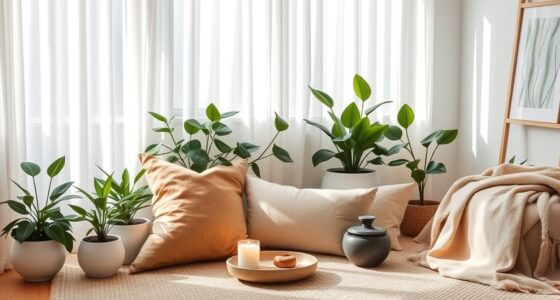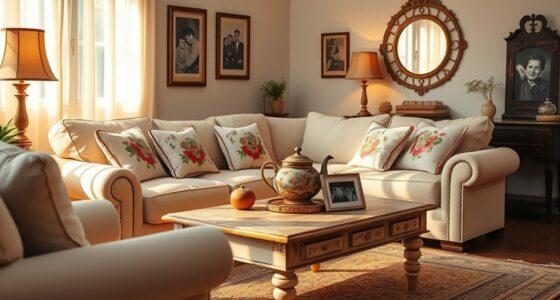To apply biophilic design, focus on connecting with nature by incorporating natural features like plants, water, and sunlight. Use organic shapes and patterns that mimic natural diversity, creating soothing environments. Maximize natural light and views of outdoor elements to enhance well-being. Reflect natural processes like seasonal changes and flowing water to foster resilience. Build local relationships using regional materials and culture. Finally, design spaces that promote human exploration and relaxation. Continue exploring these principles to create truly restorative spaces.
Key Takeaways
- Incorporate natural elements like plants, water features, and natural materials to foster biophilic connection.
- Use organic shapes, biomorphic motifs, and complex geometries inspired by nature’s diversity.
- Maximize natural light and views of the outdoors to enhance psychological well-being.
- Reflect natural patterns, processes, and variability to create familiar, calming environments.
- Design spaces that facilitate human-nature interactions, promoting emotional and physical health.
Connection to Nature and Innate Human Affinity

Have you ever wondered why you feel so drawn to natural settings? That’s your innate human affinity, or biophilia, at work. Your connection to nature pulls you toward natural elements like plants, water, and sunlight, which can boost your mental health and emotional balance. Exposure to environmental features and natural patterns triggers restorative responses rooted in our evolutionary history. Shadows, flowing water, and fire aren’t just visually appealing—they activate deep-seated responses that promote well-being. Scientific research confirms that this natural connection helps reduce stress, enhance mood, and foster creativity. Your instinctive attraction to natural landscapes, organic forms, and animal companionship isn’t accidental. It’s a fundamental part of who you are, guiding your desire for environments that support your overall health and emotional resilience. Additionally, understanding biophilic design principles can help create spaces that nurture this innate connection and improve overall well-being. Recognizing the importance of natural elements in our environments can further enhance the positive effects on mental health. Incorporating natural patterns into architectural features can also amplify these restorative benefits. For example, integrating natural cues such as daylight, greenery, and water features into indoor spaces can significantly enhance psychological comfort and rejuvenation. Moreover, advancements in blockchain technology, like Merkle trees, play a vital role in ensuring data integrity and security within digital systems.
Incorporating Natural Features and Elements
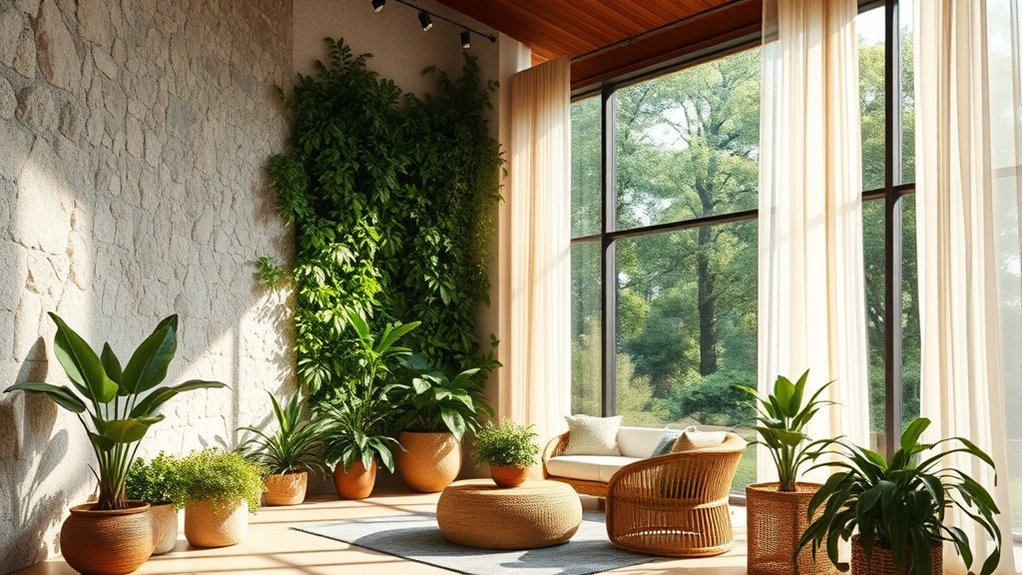
Building on your innate affinity for nature, incorporating natural features and elements into design creates a seamless connection between occupants and the environment. You can achieve this by integrating greenery through gardens, living plant facades, or courtyards that invite outdoor connection. Including water elements like ponds or fountains enhances sensory engagement and tranquility. Using natural materials such as wood, stone, or bamboo in finishes fosters tactile links to nature. Incorporate views of nature from windows or outdoor spaces to promote psychological well-being. Natural patterns and textures in furniture or wall treatments deepen this connection, making spaces feel more organic and calming. Emphasizing natural textures in decor further enriches the sensory experience, making the environment more inviting and serene. Incorporating audio-visual elements like natural sounds and images can also enhance the biophilic effect. Additionally, integrating local plant species can support biodiversity and create a more authentic natural environment. These features not only beautify your environment but also support health and reduce stress by immersing you in natural elements, which is a core principle of biophilic design.
Embracing Organic Shapes and Forms
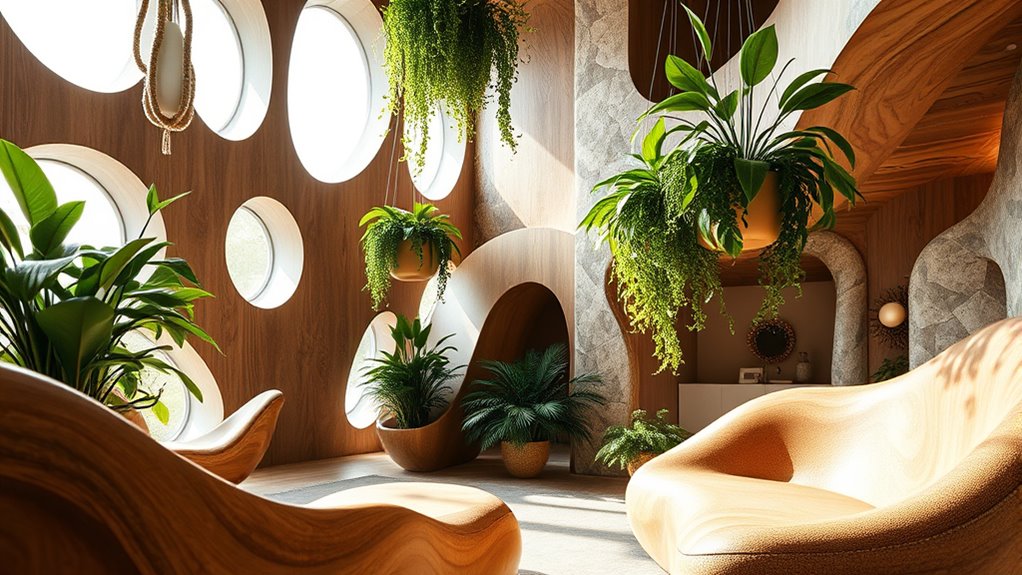
By incorporating organic shapes and forms, you create spaces that mimic the natural world’s diversity, making environments feel more inviting. Curved lines and flowing structures enhance sensory engagement, encouraging relaxation and comfort. Embracing these forms helps foster a deeper connection to nature and promotes well-being. Additionally, understanding how attention influences our creative perception can help design spaces that better support focus and mindfulness. Recognizing the role of net worth in branding and perception can also influence how spaces are valued and marketed. Incorporating DIY modifications and professional conversions in design can further personalize and optimize environments. Employing specific brewing techniques from various methods can inspire innovative approaches to space design, reflecting diverse influences and craftsmanship. Moreover, integrating sustainable fashion principles into design choices can promote eco-friendly environments that align with contemporary values.
Mimicking Natural Diversity
Embracing organic shapes and forms allows us to mirror the natural world’s rich diversity within architectural and interior design. By incorporating biomorphic motifs, irregular patterns, and natural forms, you create environments that reflect the complexity found in ecosystems. Architectural elements like arches and vaults draw inspiration from nature’s complex geometries, offering both visual interest and calming effects. Using botanical and animal-inspired shapes in furniture and fixtures enhances sensory engagement, fostering subconscious connections to natural environments. This approach supports natural diversity by mimicking patterns in nature, encouraging exploration and curiosity. Additionally, integrating complex geometries inspired by natural structures can further deepen the connection to the environment and promote a sense of harmony within the space. Incorporating natural textures and materials also enhances the authenticity and tactile experience of the environment, making it more immersive. To strengthen this connection, incorporating biophilic elements such as living walls or water features can amplify the sense of being immersed in nature. Recognizing the importance of nutritional diversity in natural ecosystems can inspire varied and resilient design choices that promote health and well-being.
Incorporating Curved Lines
Incorporating curved lines into design continues the exploration of natural diversity by emphasizing organic shapes and forms. These curved lines and natural shapes mimic natural forms like waves, leaves, and animal contours, fostering harmony and comfort. To integrate this effectively:
- Use biomorphic shapes in architecture and interior design to enhance visual interest.
- Incorporate arches, domes, and spirals in architectural elements to evoke subconscious connections to nature.
- Select furniture and pathways with flowing, curved lines to promote relaxation and emotional well-being.
- Choosing waterwick pots and other naturalistic planters can further enhance a biophilic environment by bringing organic shapes and textures indoors. Additionally, incorporating biophilic design principles can help create spaces that support mental well-being through natural integration.
- Paying attention to sustainable materials ensures that these natural forms are environmentally responsible and contribute to a healthier environment.
Enhancing Sensory Engagement
Integrating organic shapes and forms into design actively stimulates the senses and makes environments more inviting and comforting. Natural patterns like spirals, arches, and irregular outlines reflect the complexity of nature, enhancing sensory engagement. By incorporating biomorphic architecture, which draws inspiration from living organisms, you strengthen the human connection to vitality and health. Natural forms in furniture, fixtures, and architectural details evoke feelings of safety, exploration, and wonder, stimulating both visual and tactile senses. These shapes help reduce stress and improve mood by aligning with our innate preference for irregular, natural forms over rigid, geometric ones. Embracing organic shapes creates a more harmonious environment that nurtures well-being and deepens your connection to the natural world.
Reflecting Natural Patterns and Processes
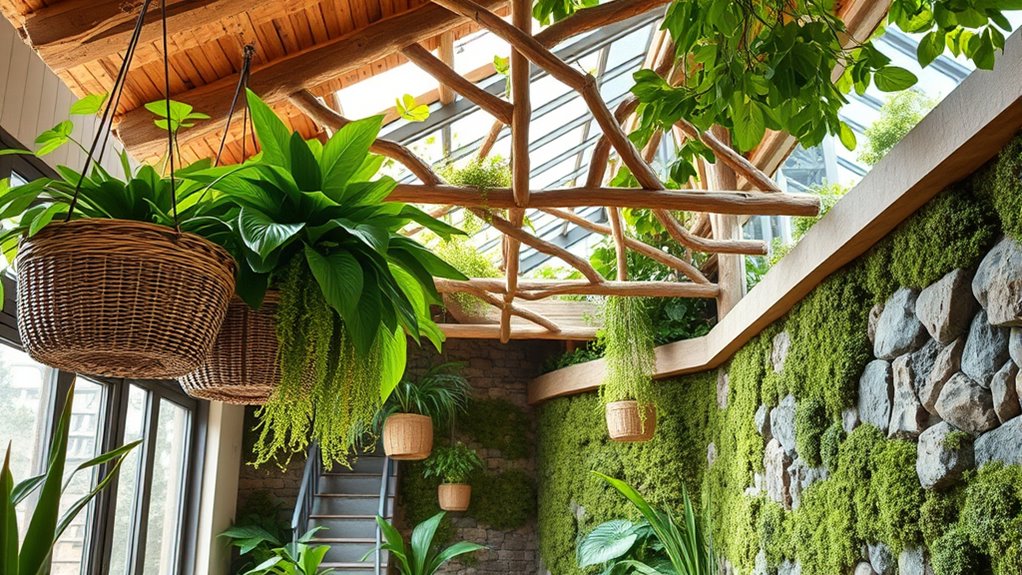
Reflecting natural patterns and processes in design creates spaces that feel intuitive and alive. By integrating elements like natural forms, textures, and light, you evoke a sense of harmony with the natural environment. Consider these key approaches:
- Incorporate natural patterns such as fractals and growth to foster familiarity and comfort.
- Use materials that weather or change over time, symbolizing natural processes and the passage of time.
- Design with variability in natural light, sound, and textures to stimulate your senses and promote relaxation.
These strategies mimic the dynamic diversity found in nature, enhancing sensory engagement. By reflecting natural processes like water flow or seasonal shifts, your environment supports both mental and physical well-being, making spaces feel more vibrant, authentic, and restorative.
Optimizing Light and Spatial Experiences
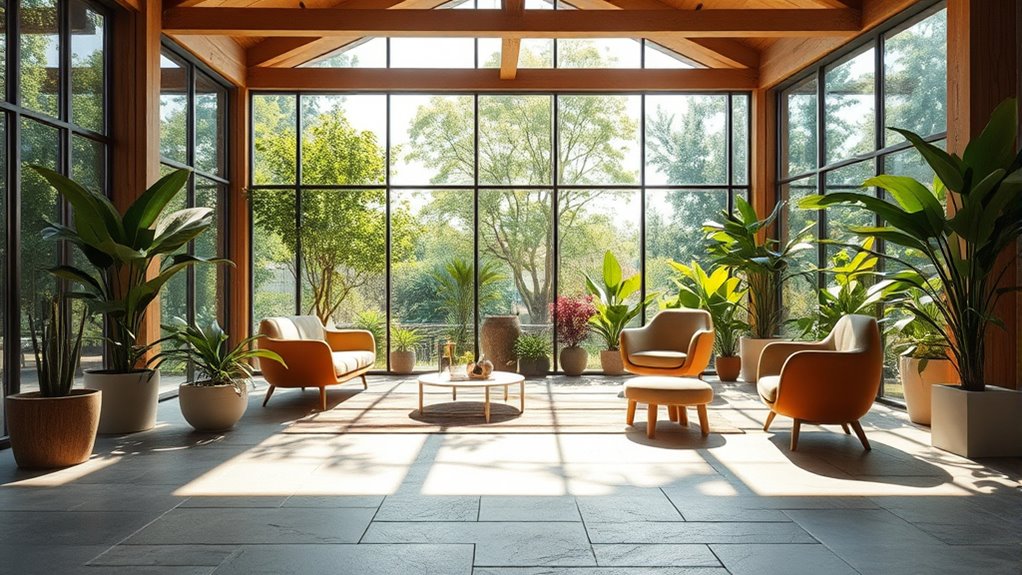
You can enhance your space by maximizing natural light through large windows and open layouts, which support your body’s internal clock and boost your mood. Using diffused light sources creates a comfortable environment that mimics outdoor conditions, reducing glare. By carefully designing for daylight access and incorporating views of nature, you’ll foster a sense of openness and connection within your space.
Natural Light Variability
Have you ever noticed how natural light shifts throughout the day, creating changing moods and atmospheres? This light variability plays a crucial role in enhancing your circadian rhythms and mood. To harness this, consider:
- Incorporating skylights and large windows to allow dynamic lighting that mimics outdoor conditions.
- Using diffused light, filters, and shading devices to maintain visual comfort during seasonal changes.
- Designing spaces with varied ceiling heights and open volumes to influence how natural light interacts within the environment.
Spatial Openness and Flow
Creating a sense of spaciousness and seamless flow within a space enhances both natural light distribution and your overall experience. An open plan design allows natural light to penetrate deeply, reducing stress and boosting mood. Varying ceiling heights and organic shapes mimic outdoor environments, fostering a feeling of freedom and exploration. Strategic placement of windows and skylights maximizes daylighting, aligning indoor lighting with your circadian rhythms for better sleep and vitality. Incorporating visual connection to outdoor landscapes through expansive glazing strengthens the indoor-outdoor connection and enhances spatial flow. Using natural materials further reinforces harmony with nature, supporting relaxation and cognitive engagement. When thoughtfully designed, spatial openness transforms your space into a calming, vibrant environment that nurtures your well-being.
Building Place-Based Relationships

Building place-based relationships in biophilic design means integrating local ecological, cultural, and historical elements to create environments that feel authentic and meaningful. To do this, you should consider:
Building place-based relationships in biophilic design creates authentic, meaningful environments rooted in local ecology and culture.
- Using indigenous materials, native plants, and landscape features that foster emotional attachment and a sense of belonging among occupants and communities.
- Designing with site-specific features like terrain, water bodies, and climate conditions to enhance ecological harmony and support regional biodiversity.
- Embedding cultural references, historic landmarks, or traditional landscape patterns that enrich the “Spirit of Place” and strengthen community identity.
Fostering Evolved Human-Nature Interactions
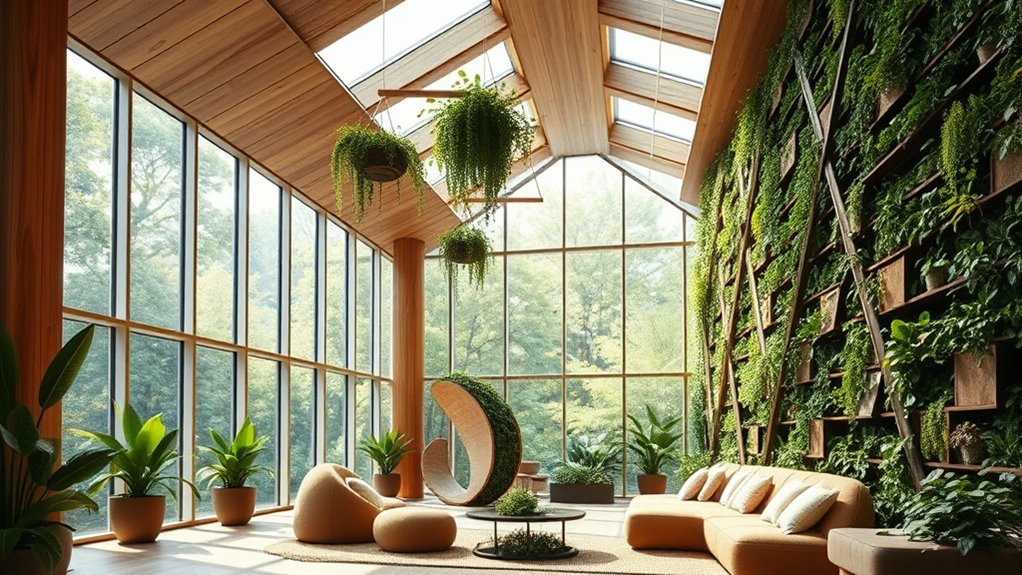
Fostering evolved human-nature interactions involves designing environments that tap into our innate instincts to seek safety, refuge, and exploration. You can strengthen the human-nature connection by incorporating natural forms—flowing shapes, varied textures, and dynamic patterns—that stimulate sensory variability and evoke emotional responses. These elements activate evolved responses, providing psychological comfort and encouraging curiosity. Purposeful environment design that offers prospect and refuge fosters a sense of security while inviting cognitive engagement with natural complexities. When spaces inspire awe and facilitate discovery, they deepen emotional connections, supporting well-being. By aligning design with our innate tendencies, you create environments that naturally nurture our bond with nature, promoting exploration, relaxation, and restorative experiences rooted in our evolutionary history.
Frequently Asked Questions
What Are the 6 Principles of Biophilic Design?
You might wonder about the six principles of biophilic design. These include incorporating environmental features like vegetation, natural shapes and forms, and patterns that mimic nature. You should also focus on optimizing light and space, creating place-based relationships, and fostering evolved human-nature connections. By applying these principles, you’ll craft spaces that boost well-being, reduce stress, and strengthen your bond with the natural world.
What Are the 5 Senses of Biophilic Design?
You’re curious about the five senses in biophilic design. You can enhance spaces by engaging sight with natural light and greenery, sound through water or bird songs, smell with plant aromas, touch via textures like bark or stone, and taste by incorporating natural or organic elements. By activating these senses, you create a multisensory environment that fosters relaxation, well-being, and a stronger connection to nature.
What Are the Pillars of Biophilic Design?
You should understand that the pillars of biophilic design include environmental features, natural shapes and forms, natural patterns and processes, light and space, and place-based relationships. These pillars guide you in creating spaces that connect people with nature, promoting well-being. By incorporating elements like vegetation, natural geometries, sensory variability, natural lighting, and contextual ties to the environment, you foster a restorative, health-enhancing environment that nurtures human-nature connections.
Who Wrote the 14 Patterns of Biophilic Design?
You might wonder who created the 14 patterns of biophilic design. These patterns were developed by Terrapin Bright Green, a sustainability consulting firm founded by Stephen Kellert. They synthesized scientific research, empirical evidence, and practical insights through collaboration among scientists, architects, and landscape professionals. Their goal was to offer a framework that helps you integrate natural elements into built environments, ultimately promoting human well-being through nature-inspired design.
Conclusion
You might think bringing nature indoors is just a trend, but really, it’s about reconnecting with what’s innately yours. Ironically, in a world obsessed with technology and concrete, embracing organic shapes and natural patterns can actually make your space feel more alive—and you. So, as you design, remember: the more you mimic nature, the more you realize how much you’ve been missing. Sometimes, going back to basics is the true innovation.


